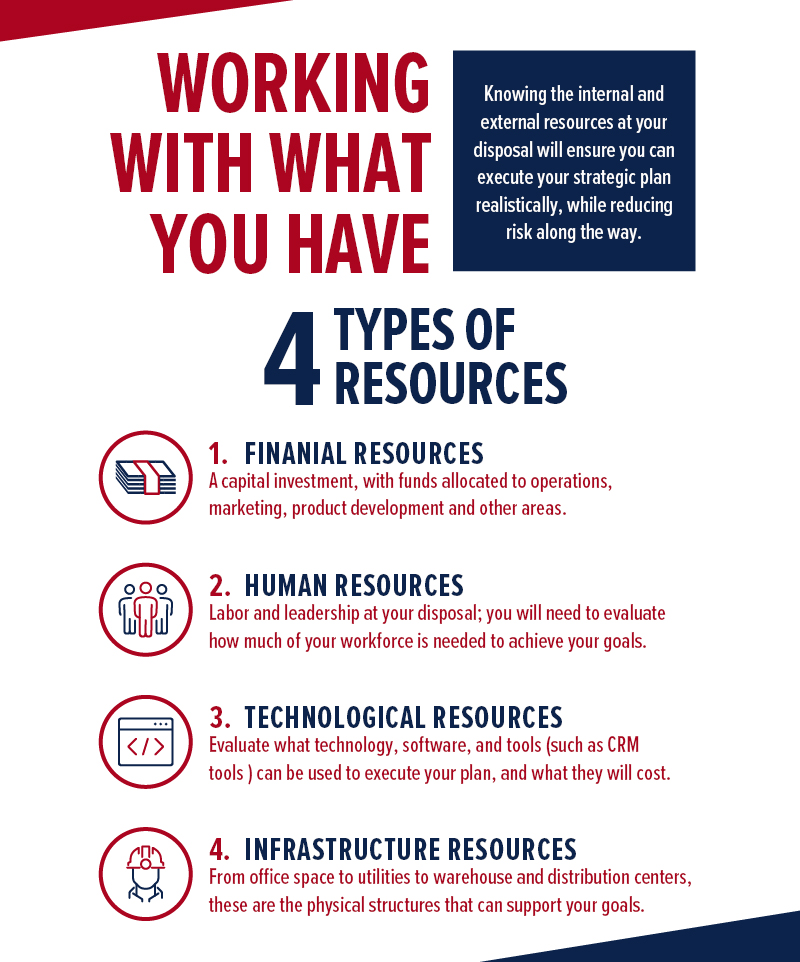When learning how to create a strategic plan, it’s critical to understand several different components first–including the steps, process, and even the differences in how to create a strategic plan versus a business plan. In the ever-changing landscape of business and life, strategic planning serves as the compass that guides organizations and individuals toward their goals and aspirations. Whether you're a budding entrepreneur seeking to launch a groundbreaking startup or a seasoned executive aiming to steer your organization toward greater heights, the ability to create robust strategic plans is an invaluable skill. It can mean the difference between thriving in the face of adversity or succumbing to the whims of an unpredictable environment. Let's begin this transformative journey and unlock the true potential of strategic planning.

What Is a Strategic Plan?
A strategic plan is a comprehensive and structured document that outlines an organization's long-term vision, mission, values, and objectives, as well as the strategies and actions required to achieve them. It serves as a documented roadmap to guide the company toward its desired future state while considering the internal and external factors that may impact its success.
At its core, a strategic plan aligns the organization's resources, capabilities, and efforts in a cohesive manner, fostering a clear direction for all stakeholders involved. It is a forward-looking blueprint that helps businesses adapt to dynamic market conditions, capitalize on opportunities, and mitigate potential risks.

What Is the Purpose of a Strategic Plan?
The purpose of a strategic plan is to provide a clear and structured roadmap that guides an organization in achieving its long-term vision and objectives. It serves as a compass that aligns the efforts of all stakeholders — from top-level executives to front-line employees — toward a common direction. The strategic plan outlines the steps, strategies, and actions required to move the organization from its current state to the desired future state, taking into account both internal capabilities and external factors.
There are three key purposes of a strategic plan:
- Perspective: Where is your business now?
- Vision: Where do you want to take it?
- Goals: What do you need to do to get there?
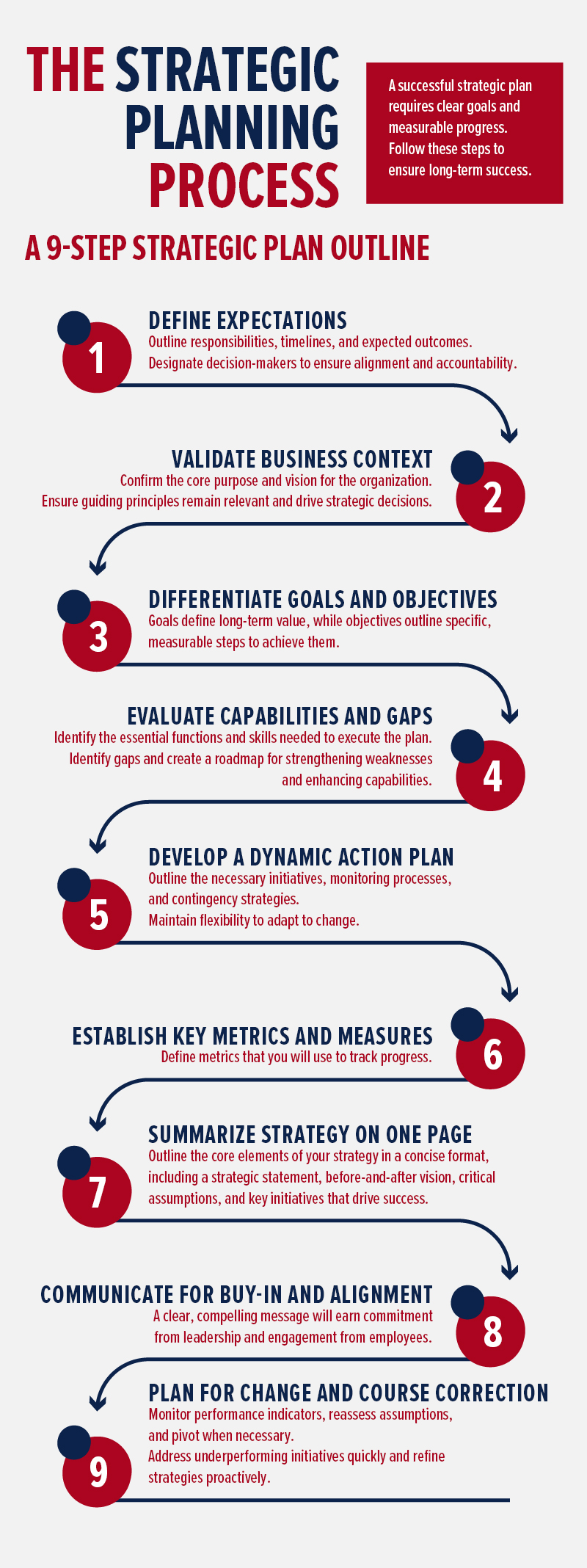
What’s the Difference Between a Strategic Plan and a Business Plan?
Let’s look at some of the key differences between the two. A strategic plan and a business plan are two distinct documents that serve different purposes and cater to various aspects of an organization's operations and growth. While they may complement each other, they address different levels of planning and focus on different timeframes. Some of the key differences between a strategic plan and a business plan include purpose and scope, timeframe, level of detail, and target audience.
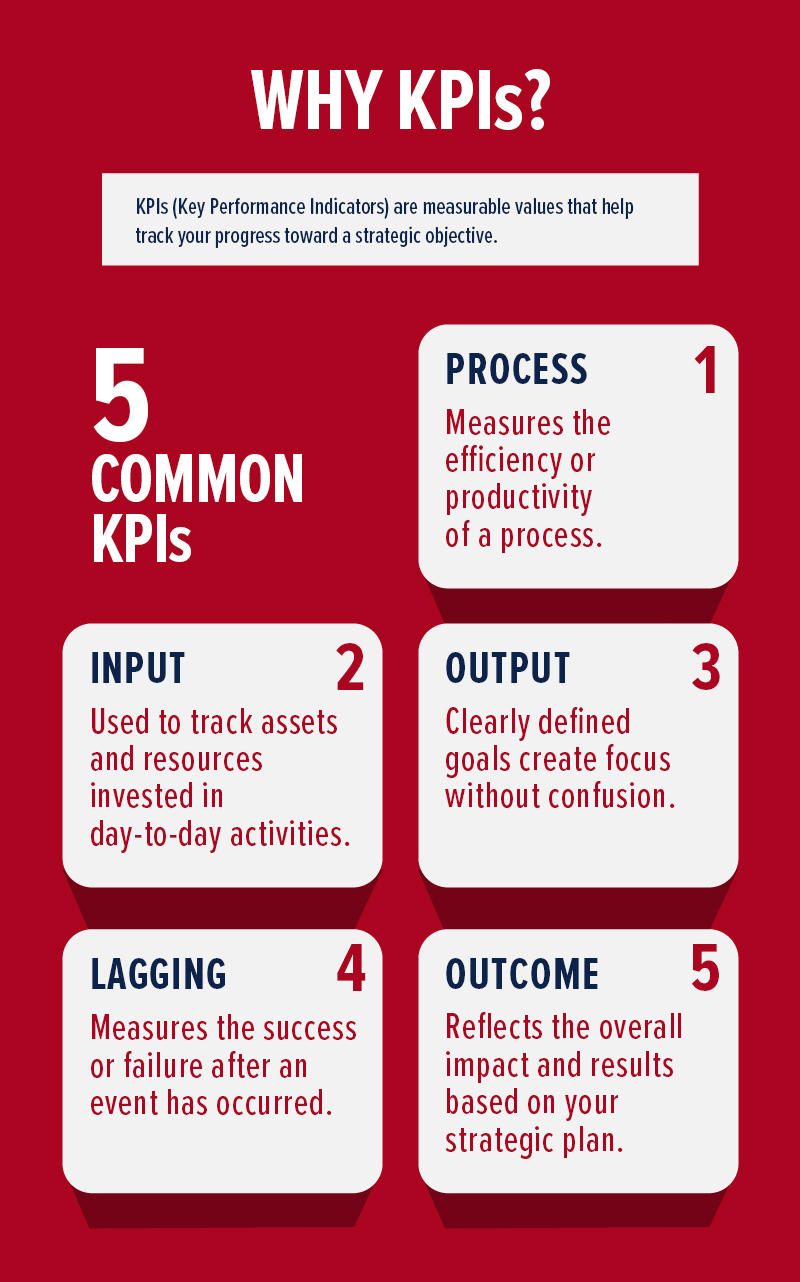
What Are the Main Elements of a Strategic Plan?
Key components of a strategic plan typically include:
- Vision and mission: The strategic plan begins by defining the organization's overarching vision, portraying the long-term future it aspires to achieve. It also includes a mission statement that encapsulates the company's purpose, values, and the essence of what it does.
- Goals and objectives: Specific, measurable, achievable, relevant, and time-bound goals and objectives are set to give the plan a tangible sense of direction. These goals should align with the organization's mission and vision, serving as milestones on the journey to success. SMART goals are a structured approach to goal-setting that uses five key criteria to ensure objectives are well-defined and achievable. The acronym stands for:
- Specific (clear description of what needs to be accomplished)
- Measurable (quantifiable metrics to track success)
- Attainable (realistic within available resources and timeframe)
- Relevant (aligned with broader priorities and meaningful to the organization)
- Time-Bound (includes a specific deadline for completion)
This framework is commonly used in business strategic planning, particularly during quarterly and annual planning sessions, to create concrete objectives that teams can effectively execute. The method helps organizations move beyond vague aspirations to actionable plans with clear success metrics and deadlines. The SMART methodology was originally developed by George T. Doran, who introduced it in a 1981 Management Review article titled "There's a S.M.A.R.T. Way to Write Management Goals and Objectives.”
- Environmental analysis: A thorough examination of the internal and external factors that could influence the organization's performance is essential. This analysis includes an assessment of strengths, weaknesses, opportunities, and threats (SWOT), as well as an understanding of the competitive landscape and market trends.
- Strategies and initiatives: Based on the analysis, the strategic plan outlines the strategies the organization will pursue to achieve its objectives. It identifies the key initiatives and projects that need to be undertaken to execute these strategies effectively.
- Performance indicators: To measure progress and success, the plan incorporates specific performance indicators and targets. These metrics help monitor the organization's performance, identify deviations from the plan, and facilitate necessary adjustments. Companies evaluate strategic planning success through key performance indicators (KPIs) that provide concrete measurements of strategy effectiveness. Here are five critical metrics to monitor:
- Working Capital serves as a company's financial fuel gauge, measuring readily available resources (cash, receivables, short-term investments) minus current liabilities. Declining working capital signals potential strategy problems or failure.
- Debt to Equity Ratio reveals how much debt fuels growth by comparing total liabilities to shareholder equity. This fundamental profitability measure requires continuous monitoring to understand the company's financial leverage.
- Current Ratio (total assets divided by total liabilities) shows a company's ability to meet financial obligations consistently. This metric directly impacts creditworthiness and investor confidence, potentially affecting growth strategies.
- Return on Equity divides net income by total shareholder equity to determine whether the company generates sufficient revenue to satisfy current investors and attract new ones.
- Customer Acquisition Cost to Lifetime Value compares spending on attracting customers versus the value each customer brings over time. This metric evaluates sales and marketing performance while informing financial forecasts.
These metrics transcend specific strategies and provide universal indicators of company performance. The text emphasizes that strategic leaders need real-time access to these KPIs through automated dashboards and tools, allowing data to guide decision-making rather than consuming time with manual number-crunching.
- Resource allocation: The strategic plan addresses the allocation of resources — including financial, human, and technological assets — to support the implementation of the strategies and initiatives.
- Risk management: As no plan is foolproof, the strategic plan should account for potential risks and challenges. Risk management strategies and contingency plans are developed to address unforeseen circumstances.
- Implementation and monitoring: Execution is a crucial aspect of the strategic plan. It involves defining responsible parties, establishing timelines, and creating a monitoring and evaluation system to track progress and ensure accountability.
How to Create a Strategic Plan
Gartner outlines a step-by-step process for turning your strategy into action:
- Outline Expectations: Begin by clearly defining what success looks like for your organization. This involves establishing the desired outcomes, setting realistic timelines, and identifying key stakeholders who will be impacted by the strategic plan. Document the scope of the planning effort and clarify what the strategy should accomplish. This step ensures everyone involved understands the purpose and anticipated results before diving into detailed planning.
- Verify the Business Context: Conduct a thorough analysis of your current business environment, including market conditions, competitive landscape, regulatory factors, and economic trends. This involves gathering data on customer needs, industry dynamics, and external forces that could impact your strategy. Understanding the business context helps ensure your strategic plan is grounded in reality and addresses actual market conditions rather than assumptions.
- Set Goals and Objectives: Transform your expectations into specific, actionable goals using frameworks like SMART criteria. Establish both long-term strategic goals and shorter-term tactical objectives that support those broader aims. Ensure goals are aligned with your organization's mission and vision while being challenging yet achievable. This step creates the foundation for all subsequent planning activities.
- Assess Your Capabilities: Conduct an honest evaluation of your organization's current strengths, weaknesses, resources, and capabilities. This includes analyzing financial resources, human capital, technological infrastructure, operational processes, and core competencies. Identify gaps between what you have and what you need to achieve your goals. This assessment informs realistic planning and helps prioritize where to invest or improve.
- Develop an Action: Plan Create detailed implementation plans that specify who will do what, when, and how. Break down strategic goals into specific initiatives, projects, and tasks with clear timelines and resource requirements. Assign ownership and accountability for each element. The action plan should bridge the gap between high-level strategy and day-to-day execution, providing a roadmap for implementation.
- Set Measures and Metrics: Establish key performance indicators (KPIs) and metrics that will track progress toward your strategic objectives. Define both leading indicators (predictive measures) and lagging indicators (outcome measures) to monitor performance. Set baseline measurements and target benchmarks. This step ensures you can measure success, identify problems early, and make data-driven adjustments to your strategy.
- Limit the Strategy to One Page: Distill your entire strategic plan into a concise, one-page summary that captures the essential elements: goals, key initiatives, success metrics, and timelines. This forces clarity and focus while creating a communication tool that's easy to share and understand across the organization. The one-page format ensures the strategy remains accessible and memorable for all stakeholders.
- Drive the Plan Home: Implement comprehensive communication and change management efforts to ensure the strategy is understood, embraced, and executed throughout the organization. This involves training sessions, regular updates, alignment of individual goals with strategic objectives, and creating accountability structures. Success depends on translating strategic intent into everyday actions and decisions across all levels of the organization.
- Respond to Change: Establish processes for monitoring the business environment and adapting the strategy as conditions change. Build flexibility into your planning process through regular strategy reviews, scenario planning, and contingency preparations. Create mechanisms for gathering feedback, assessing performance against goals, and making necessary adjustments. Strategic planning should be viewed as an ongoing process rather than a one-time event, allowing the organization to remain agile and responsive to new opportunities and challenges.
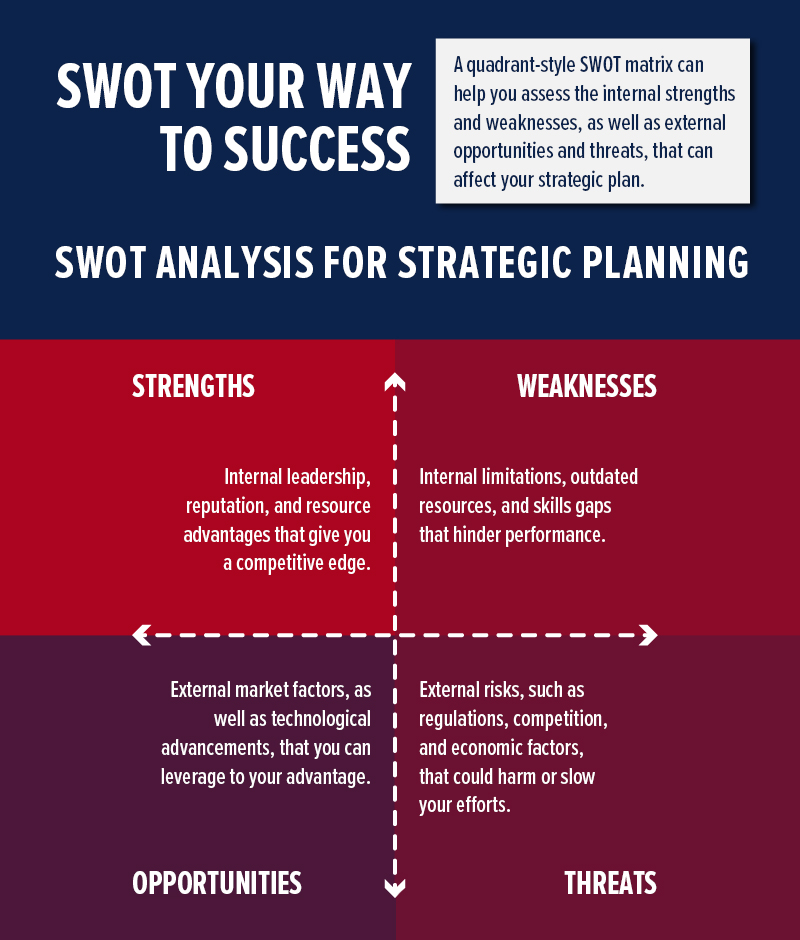
What Is the Strategic Planning Process?
The strategic planning process is a structured and systematic approach used by businesses to develop an actionable strategic plan that guides their long-term direction, goals, and actions. It involves a series of steps and activities that help leaders and stakeholders analyze the internal and external environment, set objectives, devise strategies, and create a roadmap for the organization's future success. While specific methodologies may vary, the core elements typically include the following:
1. Vision, Mission, and Values
- Defining the organization's vision: Establishing a clear and inspiring vision of the organization's desired future state. This vision serves as the guiding star, setting the ultimate destination for the organization to strive for.
- Crafting the mission statement: Encapsulates the organization's purpose, core activities, and value it provides to its stakeholders. It answers the question, "Why does the organization exist?"
- Identifying core values: Identifying the fundamental principles and beliefs that guide the organization's culture and decision-making.
2. Environmental Analysis
- Conducting a SWOT analysis: Analyzing the organization's internal strengths and weaknesses, as well as the external opportunities and threats in the market and the broader business environment.
- Identifying trends and challenges: Assess market trends, emerging technologies, regulatory changes, and other relevant factors that may impact the organization's future.
3. Goal-setting
- Defining strategic objectives: Set specific, measurable, achievable, relevant, and time-bound (SMART) objectives that align with the long-term vision and mission.
4. Strategy Formulation
- Developing strategic initiatives: Devise high-level strategies and action plans to achieve the set objectives. These initiatives may include market expansion, product development, cost optimization, innovation, and more.

5. Resource Allocation
- Identifying resource requirements: Determine the resources — such as finances, personnel, technology, and infrastructure — needed to execute the strategic initiatives successfully.
- Prioritizing initiatives: Ensure the most critical and impactful initiatives receive the necessary focus and attention.
6. Implementation and Execution
- Assigning responsibilities: Assign and execute each strategic initiative. Clear accountability and ownership are crucial for successful implementation.
- Developing action plans: Detailed action plans with timelines and milestones for each initiative, outlining the steps required for successful execution.
7. Monitoring and Evaluation
- Establishing performance metrics: Key performance indicators (KPIs) measure progress and success toward the strategic objectives.
- Regular review and adjustment: The strategic plan requires periodic review and adjustment to remain relevant in a changing environment. Organizations continuously monitor performance, adapt to new challenges, and update the plan as needed.
8. Communication and Alignment
- Communicating: Effective communication throughout the organization ensures all the employees understand and align with the goals and priorities.
- Engaging stakeholders: Involving key stakeholders — including employees, customers, suppliers, and investors — fosters support and commitment to the strategic direction.
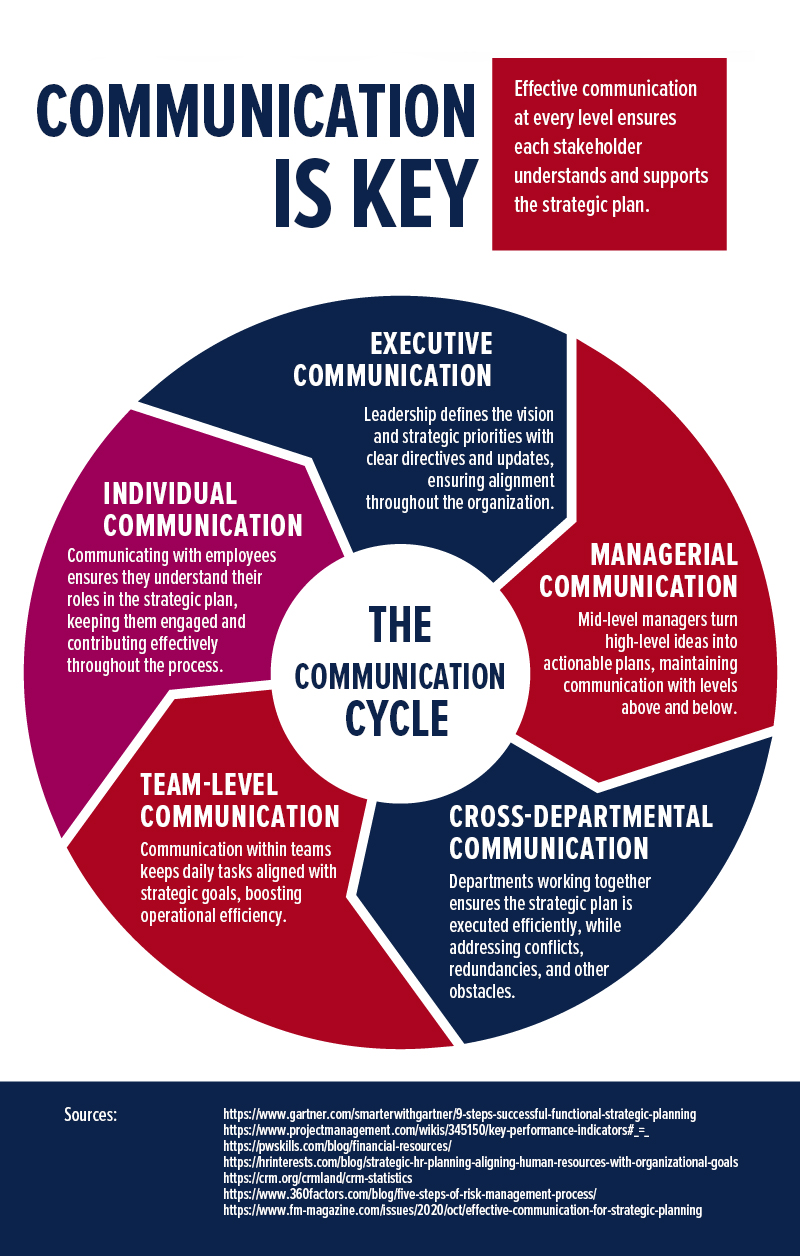
What Are Some Best Practices for Strategic Planning?
Strategic planning doesn’t just happen once, but rather it is a living, breathing operation within your organization. Therefore, you should continually work to improve it with each iteration. Here are some best practices for your strategic planning:
- Treat Strategic Planning as an Ongoing Process: Strategic planning should be viewed as a continuous improvement cycle rather than a one-time event. It requires ongoing attention, regular updates, and constant refinement to remain effective and relevant to your organization's evolving needs.
- Adopt a Simple Framework: While strategic planning is inherently complex, use a straightforward framework that everyone can understand. Structure your planning around five fundamental questions: Who are we? Where are we now? Where do we want to go? How will we know when we've arrived? How do we plan to get there?
- Engage All Stakeholders Throughout the Process: Include stakeholders early, during, and after the planning process rather than waiting until a plan is already developed. Since stakeholders will be responsible for implementing the plan, their involvement and buy-in are crucial for success.
- Establish Clear Measurable Results: Define specific performance measures and metrics that clearly indicate when goals have been achieved. Without measurable outcomes, it's impossible to determine success or failure, making the plan ineffective.
- Assign Individual Accountability: Designate specific people responsible for each initiative within your strategic plan. Without clear ownership and accountability, tasks remain unfinished because no one takes responsibility for their completion.
- Set Firm Due Dates: Establish agreed-upon deadlines for all initiatives to prioritize work and provide a framework for resource allocation. Without due dates, important work often gets postponed indefinitely.
- Define and Budget for Costs: Identify all costs associated with strategic initiatives, whether direct or indirect. Integrate strategic planning with budgeting processes to ensure important priorities receive proper financial support. Your budget should reflect your strategic priorities.
- Align Everything with the Strategic Plan: Ensure all organizational activities align with the strategic plan, including budgets, operational plans, policies, meetings, and evaluations. If activities don't support the strategic direction, question why they're being pursued.
- Communicate Extensively and Consistently: Over-communicate the strategic plan using multiple channels to reach all stakeholders. Everyone should understand both the plan itself and their specific role in executing it. Meet stakeholders where they are by using their preferred communication methods.
- Make Strategic Planning Part of Your Culture: Embed strategic planning into the organization's culture and daily operations. Leadership must model this behavior for it to take root throughout all levels. When strategic thinking becomes "the way things are done," it produces transformational results and becomes easier to maintain over time.
Overview: How to Create a Strategic Plan
Strategic plans are comprehensive roadmaps that outline an organization's long-term vision, mission, and objectives, along with the strategies and actions needed to achieve them. These forward-looking blueprints align resources, guide decision-making, and foster adaptability in the face of change. They enable businesses to navigate complexities, capitalize on opportunities, and overcome challenges while ensuring a cohesive direction for all stakeholders. By setting clear goals and defining initiatives, strategic plans empower organizations to thrive, grow, and achieve sustained success.


